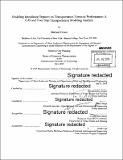Modeling inundation impacts on transportation network performance : a GIS and four-step transportation modeling analysis
Author(s)
Dowd, Michael G
DownloadFull printable version (50.04Mb)
Alternative title
GIS and four-step transportation modeling analysis
Other Contributors
Massachusetts Institute of Technology. Department of Civil and Environmental Engineering.
Advisor
P. Christopher Zegras and Mikel Murga.
Terms of use
Metadata
Show full item recordAbstract
The world's leading climate scientists have reached a consensus that "[w]arming of the climate system is unequivocal" (IPCC, 2007). This warming will carry with it a host of consequences for the global community, including increased occurrence of flooding. Little focus has been placed on the operation of transport systems during, or shortly after inundation events. Inundation affects the availability and quality of network assets (i.e. Transportation Supply) and inhabitable land, which produces and attracts transportation users (i.e. Demand). In this thesis, I apply an altered four-step transportation modeling method to allow for the analysis of impacts in a single set time: modeling an event rather than a future equilibrium scenario. I show how traditional four-step models can be used to produce valuable metrics describing performance of the disrupted transportation system. Such metrics contribute to understanding potential consequences and planning for mitigation and response. Using the Boston Metro Region as a case study, and a four-step model for the year 2010, 1 demonstrate a method (Inundation Impact Assessment) for quantifying transport network impacts under six different inundation levels, one-foot to six-feet. The results indicate that inundation has widespread impacts on the ability of persons to complete trips and the performance of both the auto and transit networks. I then demonstrate how this method can be applied to examine different infrastructure projects in the future, modeling two different demographic scenarios for the year 2030 with two different BRT alignments. The goal is to evaluate potential contribution of BRT to recoup trips lost by the impact of inundation on other transit links. The methods and approaches used in this work show how such four-step models can be used to plan for inundation events. This method provides significant amounts of data that can be used to assess the value of potential interventions, such as the protection of mobility or the reinforcement of transportation network performance.
Description
Thesis: M.C.P., Massachusetts Institute of Technology, Department of Urban Studies and Planning, 2015. Thesis: S.M. in Transportation, Massachusetts Institute of Technology, Department of Civil and Environmental Engineering, 2015. Page 262 blank. Cataloged from PDF version of thesis. Includes bibliographical references (pages 248-251).
Date issued
2015Department
Massachusetts Institute of Technology. Department of Civil and Environmental Engineering; Massachusetts Institute of Technology. Department of Urban Studies and PlanningPublisher
Massachusetts Institute of Technology
Keywords
Urban Studies and Planning., Civil and Environmental Engineering.